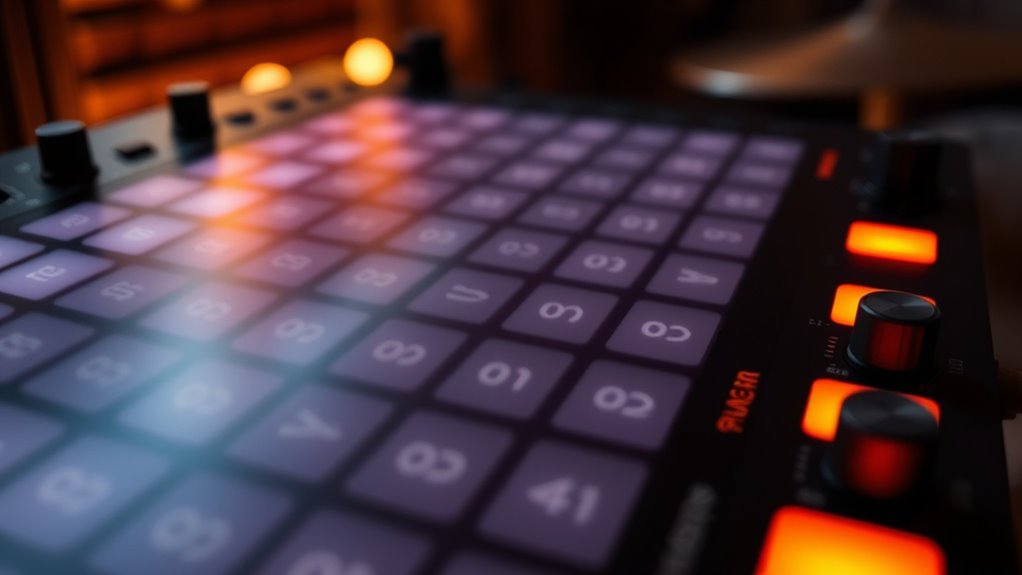To keep your MIDI drums feeling human, avoid over-quantizing and focus on preserving subtle timing variations and dynamics. Instead of tightening every hit perfectly to the grid, use gentle timing adjustments, swing, and velocity nuances that mimic real performance. Incorporate ghost notes, accents, and slight delays to add groove and authenticity. Balancing tightness with natural imperfections guarantees your drums sound lively and expressive. Explore these strategies further to create more organic, human-like rhythms.
Key Takeaways
- Apply partial or gentle quantization, correcting only noticeably off-beat hits while preserving natural timing variations.
- Use swing and subtle manual nudging to introduce human-like timing shifts, avoiding rigid grid alignment.
- Incorporate velocity dynamics, accents, and ghost notes to add expressiveness and depth to the MIDI performance.
- Automate or randomize velocities to mimic human variation and prevent a mechanical feel.
- Layer multiple samples and avoid over-quantizing to maintain organic rhythm and the lively human feel.
Understanding the Natural Human Drumming Feel

To truly grasp the natural human drumming feel, you need to recognize that it’s characterized by subtle imperfections and variations in timing and dynamics. These nuances give your drumming a sense of rhythmic subtlety, making it feel alive and genuine. When you listen to real drummers, you’ll notice that their hits aren’t perfectly synchronized; instead, they breathe with slight delays and dynamic shifts that convey expressive authenticity. Trying to replicate this in MIDI requires more than just quantizing everything perfectly. Embrace small timing inconsistencies and dynamic fluctuations to preserve the human element. By doing so, your programmed drums won’t sound robotic but will instead evoke the warmth and feel of a real performer, making your music more engaging and emotionally resonant. Additionally, understanding the vetted practices for maintaining a human feel can help guide your adjustments and ensure your MIDI drums capture that authentic essence.
The Risks of Over-Quantizing Your MIDI Drums

While quantizing can help tighten up your MIDI drums, overdoing it can strip away the natural feel that makes your rhythms expressive and lively. Excessive quantization risks sacrificing drum machine authenticity, making your beats sound mechanical and sterile. You might fall into MIDI editing pitfalls, where small timing adjustments lead to a loss of groove and human character. Over-quantizing also reduces the dynamic range, making your drums sound uniform and less engaging. This can diminish the emotional impact of your performance, turning a lively rhythm into a robotic pattern. To preserve the soul of your drums, avoid applying perfect grid alignment without considering the subtle variations that give your music its human touch. Balance is key—to keep your beats lively and authentic. Additionally, understanding the contrast ratio of your digital instruments can help maintain a natural balance between brightness and depth in your sound.
Recognizing Human Imperfections and Variations

Understanding human imperfections and variations is essential for maintaining the natural feel of your drums. No drummer plays perfectly on every hit; they naturally introduce subtle timing shifts, creating a unique swing feel. These small timing deviations contribute to the groove and make your drums sound lively and organic. Dynamic expression also varies from hit to hit, with accents, ghost notes, and subtle tempo fluctuations adding depth. Recognizing these nuances helps you avoid over-quantizing, which can strip away this authenticity. By paying attention to how real performers breathe life into their playing, you can preserve these imperfections in your MIDI drums. This awareness allows you to balance precision with authenticity, ensuring your programmed beats retain the human feel that connects listeners emotionally. Understanding these subtle variations is crucial for capturing the expressive qualities that differentiate mechanical precision from authentic human performance.
Techniques for Preserving Groove and Dynamics

Preserving groove and dynamics requires intentional techniques that maintain the natural feel of your drums. To keep your tracks lively, focus on:
- Incorporating swing feel to add rhythmic humanization, subtly delaying or advancing certain hits.
- Using ghost notes to create dynamic variation and emphasize groove without overpowering the main hits.
- Adjusting velocity levels manually to reflect natural variations in force, avoiding robotic uniformity.
- Applying subtle timing shifts to mimic human playback, enhancing the groove’s authenticity.
- Utilizing track development techniques to craft evolving rhythmic patterns that feel organic and engaging.
These methods help retain the feel of live performance, making your MIDI drums groove naturally and sound less quantized. By carefully balancing swing, ghost notes, velocity, timing, and development, you preserve expressive dynamics and maintain the human feel in your drum tracks.
Using Quantization Sparingly and Strategically

Using quantization sparingly and strategically allows you to maintain the natural groove you’ve worked hard to develop. Instead of applying tight grid corrections everywhere, focus on subtle adjustments that preserve expressive dynamics and rhythmic subtlety. Quantize only the most off-beat or inconsistent hits, leaving the rest untouched to retain human feel. By doing so, your drums will sound more lively and less robotic. Use gentle quantization settings or partial grid corrections to tighten timing without sacrificing the groove. Remember, the goal isn’t perfect timing but a balanced mix of precision and feel. This approach ensures your MIDI drums stay expressive and dynamic, avoiding the sterile sound that over-quantization often produces. Strategic use keeps your drum performance engaging and authentic.
Incorporating Humanizing Tools and Features

To keep your music feeling natural, try humanizing timing variations by subtly shifting note positions. Incorporate groove templates to add consistent swing and feel, and adjust velocity dynamics to create more expressive performances. These tools help maintain rhythm integrity while avoiding the mechanical feel of over-quantization. Additionally, implementing variety of materials in your MIDI programming can enhance the realism of your drum tracks by simulating different acoustic environments.
Humanize Timing Variations
Incorporating humanizing tools and features into your music or audio projects can make timing feel more natural and less mechanical. To achieve a convincing swing feel or swing timing, you should introduce subtle timing variations. Consider these techniques:
- Adjust the timing of individual hits slightly off the grid to mimic human imperfections.
- Use swing quantization to shift notes into a groove that emphasizes the natural swing feel.
- Apply random timing jitter within a small range to avoid rigid, robotic rhythms.
- Incorporate velocity variations alongside timing tweaks to reflect human dynamics.
- Experiment with preppy dog names to add a creative and personalized touch to your project’s naming conventions, just as subtle variations can bring a natural feel to drum patterns.
These methods help create a more authentic, lively drum performance, emphasizing the natural inconsistencies that define human timing and swing feel.
Use Groove Templates
Groove templates provide a powerful way to add human feel to your digital recordings by capturing and applying rhythmic nuances. By using groove templates, you can incorporate natural swing feel and subtle timing variations that mimic real drummers. These templates are designed to reflect the groove of a performance, allowing you to transfer that feel onto your MIDI drums effortlessly. When you apply a groove template, it adjusts the timing and rhythmic placement of your MIDI notes, giving them a more human and less robotic quality. This technique helps preserve the dynamics and swing feel that often get lost in quantization. Instead of rigidly lining up every hit, groove templates embed the organic feel that makes your MIDI drums sound lively and human. Additionally, integrating these tools encourages a mindful approach to attention, fostering a deeper connection with your creative process.
Adjust Velocity Dynamics
Adjusting velocity dynamics allows you to enhance the natural feel of your MIDI recordings after applying groove templates. By fine-tuning velocity variation, you can improve the dynamic range, making your drums sound more expressive and human. To achieve this:
- Use velocity curves to shape how hard each hit plays, adding subtle variation.
- Apply velocity randomization to introduce slight differences between hits, avoiding robotic uniformity.
- Automate velocity changes to emphasize accents or ghost notes, enhancing groove.
- Utilize humanize features in your DAW to generate realistic velocity variation across the entire track.
- Considering the seasonal variations in New England camping can inspire you to experiment with different dynamic settings based on the mood and environment of your project.
These techniques help maintain musicality without sacrificing precision, ensuring your MIDI drums sound lively and authentic. Adjusting velocity dynamics is key to preserving the organic feel while controlling the overall dynamic range.
Balancing Tightness and Feel in Your Drum Tracks

To keep your drum tracks lively, you need to find the right balance between tightness and feel. Adjust your quantization settings carefully to preserve the human groove without sacrificing timing precision. Remember, small tweaks can make a big difference in maintaining a natural, musical rhythm. Being aware of common causes of failure in related systems can help you troubleshoot and refine your editing approach for more authentic results.
Preserving Human Groove
While quantization can tighten up your drum tracks, it often risks stripping away the human feel that makes them groove naturally. To preserve that groove, focus on maintaining a balance between tightness and looseness. Here are some strategies:
- Use subtle timing variations to retain drum machine authenticity without introducing obvious quantization artifacts.
- Apply gentle swing settings to add a natural groove while avoiding mechanical precision.
- Manually adjust a few notes slightly off-grid to create a more human feel.
- Incorporate velocity dynamics to add nuance, making the performance feel less uniform.
- Pay attention to the Bedroom principles of creating a warm, authentic atmosphere that enhances the organic feel of your MIDI drums.
These techniques help keep your MIDI drums lively, authentic, and grooving, rather than sterile and robotic. The goal is to maintain that essential sense of human rhythm while avoiding over-quantization.
Adjusting Quantization Settings
Fine-tuning your quantization settings allows you to find the right balance between precision and groove. Instead of applying full, rigid quantization, experiment with weaker settings or selective nudging to preserve the human feel. Recognize that a perfect, machine-like timing can introduce quantization artifacts, making your drums sound sterile. Adjust the grid to match the natural swing and subtle timing variations of a human drummer. You might also use features like “strength” or “humanize” controls to add slight randomness, reducing the mechanical feel. Remember, the goal isn’t to eliminate all imperfections but to balance tightness with musicality. By carefully adjusting these settings, you maintain the groove while minimizing quantization artifacts, resulting in a more lively, human-sounding drum track.
Practical Tips for Achieving a Lively Drum Sound

Achieving a lively drum sound starts with capturing the right energy during the recording process. When working with synthesized percussion or electronic beats, focus on subtle nuances that preserve human feel. To enhance liveliness:
- Use dynamic velocity variations instead of uniform hits.
- Incorporate subtle timing shifts to mimic human groove.
- Layer different drum samples for richer texture.
- Avoid over-quantizing; keep some natural imperfections.
These steps ensure your MIDI drums feel less sterile and more expressive. Incorporate slight timing deviations and velocity changes to maintain swing and feel. When editing, resist the urge to perfect every hit, allowing the natural feel of the performance to shine through. This approach applies equally to synthesized percussion and electronic beats, balancing precision with human expressiveness.
Frequently Asked Questions
How Can I Tell if My MIDI Drums Sound Natural Enough?
To tell if your MIDI drums sound natural enough, listen for groove consistency and timing accuracy. If your drums feel robotic or too perfect, they might lack human feel. Play back your tracks and focus on subtle timing variations, dynamics, and groove. If it still sounds tight but lifeless, consider slightly adjusting the timing or adding subtle velocity differences to bring more human feel into your performance.
What Are Common Signs of Over-Quantization in My Tracks?
Imagine your tracks suddenly turn into a robot army—total timing rigidity and a lifeless, robotic feel. That’s a clear sign of over-quantization. You might notice your drums sound unnaturally perfect, with no human groove or swing. If everything lines up perfectly without any human imperfections, you’re likely over-quantizing. It’s time to loosen those grid lines and let some natural variation breathe back into your MIDI drums.
Which Genres Benefit Most From a Humanized Drum Feel?
You’ll find that jazz and genres emphasizing a live groove benefit most from a humanized drum feel. These styles thrive on subtle imperfections and swing, which bring authenticity and warmth to your tracks. By adding slight timing variations and dynamics, you preserve the jazz authenticity or lively energy of a live performance. This approach keeps your drums feeling natural and engaging, avoiding the sterile sound of over-quantization.
Can Human Imperfections Improve the Emotional Impact of My Drums?
Ever wondered if human imperfections could heighten your drum’s emotional impact? When you embrace groove variability and dynamic expression, you create a more authentic, compelling feel. These subtle imperfections—like slight timing shifts or velocity changes—add life and tension, drawing listeners in deeper. By intentionally avoiding over-quantization, you let your drums breathe, making your music resonate more emotionally and connect on a genuine, human level.
What Are Quick Ways to Add Subtle Variations Without Complex Editing?
To add subtle variations quickly, focus on velocity variation and timing nudges. Slightly tweak the velocity of certain hits to create dynamic accents, making your drums feel more natural. Use small timing nudges on specific hits to introduce human-like imperfections without overdoing it. These quick adjustments require minimal editing but markedly enhance the emotional feel, keeping your MIDI drums lively and expressive without losing the groove.
Conclusion
While it might seem easier to fully quantize your MIDI drums for perfection, embracing some human imperfections keeps your groove lively and authentic. Don’t worry about slight timing variations—they add character and feel that rigid quantization can’t replicate. By strategically blending tightness with natural fluctuations, you’ll craft drum parts that groove effortlessly and sound more engaging. Remember, a little imperfection isn’t a flaw; it’s what makes your drums truly soulful.










